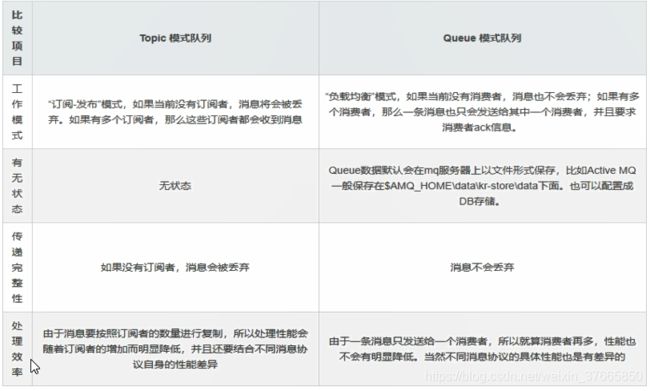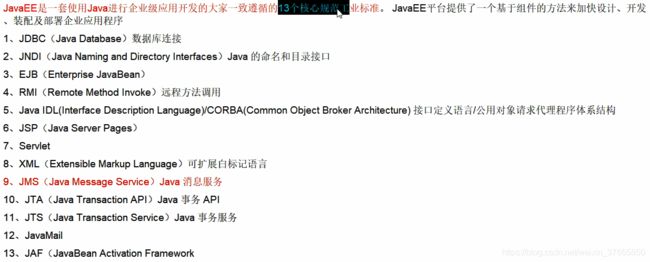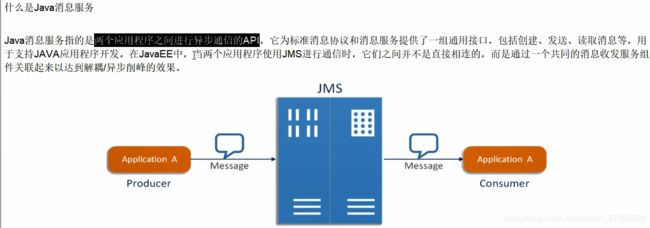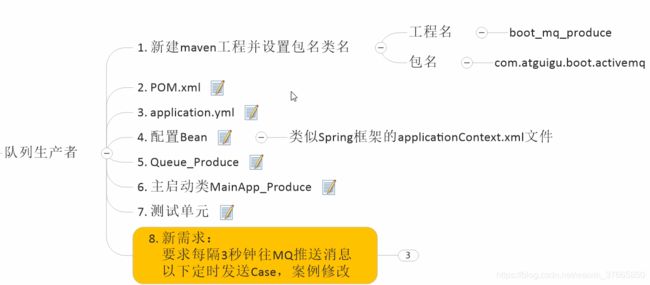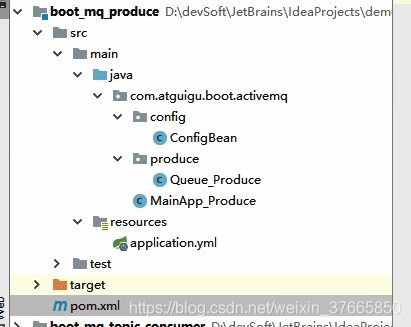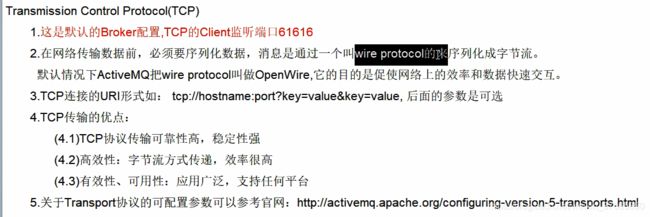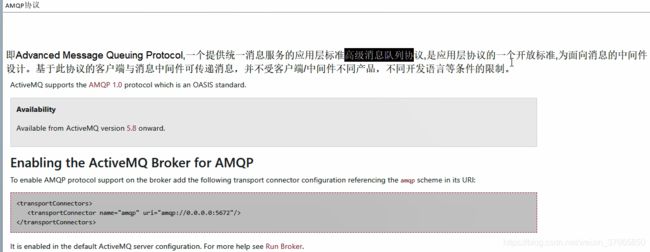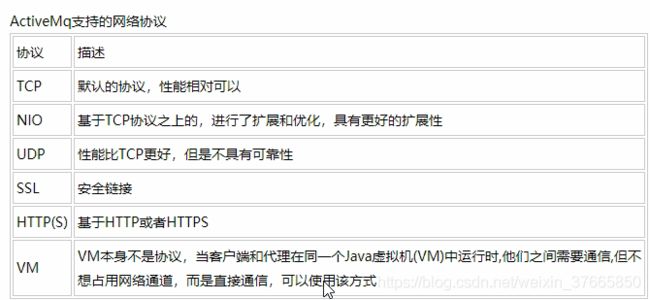ActiveMQ学习笔记(一)
MQ:消息队列/中间件
MQ产品种类:RabbitMQ、Kafka、RocketMQ、ActiveMQ
作用:解耦、削峰、异步
MQ之ActiveMQ:

activeMQ前台端口8161 后台端口61616
activeMQ启动命令:./activemq start
activeMQ关闭命令:./activemq stop
activeMQ重启命令:./activemq restart
查询是否正常启动:netstat -anp|grep 61616 查看61616端口是否被占用
关闭防火墙:service iptables stop
ActiveMQ实践:
1:新建maven工程activeMq_demo,依赖如下:
<dependencies>
<!--activeMQ需要的jar包-->
<dependency>
<groupId>org.apache.activemq</groupId>
<artifactId>activemq-all</artifactId>
<version>5.15.9</version>
</dependency>
<dependency>
<groupId>org.apache.xbean</groupId>
<artifactId>xbean-spring</artifactId>
<version>3.16</version>
</dependency>
<!--下边是junit/log4j等基础配置-->
<dependency>
<groupId>org.slf4j</groupId>
<artifactId>slf4j-api</artifactId>
<version>1.7.25</version>
</dependency>
<dependency>
<groupId>ch.qos.logback</groupId>
<artifactId>logback-classic</artifactId>
<version>1.2.3</version>
</dependency>
<dependency>
<groupId>org.projectlombok</groupId>
<artifactId>lombok</artifactId>
<version>1.16.18</version>
<scope>provided</scope>
</dependency>
<dependency>
<groupId>junit</groupId>
<artifactId>junit</artifactId>
<version>4.12</version>
</dependency>
</dependencies>编写生产者编码:
import org.apache.activemq.ActiveMQConnectionFactory;
import javax.jms.*;
public class JmsProduce {
public static final String ACTIVEMQ_URL = "tcp://192.168.215.129:61616";
public static final String QUEUE_NAME = "queue01";
public static void main(String[] args) throws JMSException {
//1:创建连接工厂,按照给定的url地址,采用默认的用户名密码
ActiveMQConnectionFactory activeMQConnectionFactory = new ActiveMQConnectionFactory(ACTIVEMQ_URL);
//2:通过连接工厂获取连接connection
Connection connection = activeMQConnectionFactory.createConnection();
connection.start();
//3:创建会话session
//两个参数:第一个事务,第二个叫签收
Session session = connection.createSession(false, Session.AUTO_ACKNOWLEDGE);
//4:创建目的地(具体是队列还是主题Topic)
Queue queue = session.createQueue(QUEUE_NAME);
//5:创建消息生产者
MessageProducer messageProducer = session.createProducer(queue);
//6:通过使用消息生产者生产3条消息发送到MQ队列里
for (int i=0;i<3;i++){
//7:创建消息
TextMessage textMessage = session.createTextMessage("msg-----"+i);
//8:通过messageProducer发送给mq
messageProducer.send(textMessage);
}
//9:关闭资源
messageProducer.close();
session.close();
connection.close();
System.out.println("*************消息发布到MQ完成");
}
}运行JmsProduce的main方法,结果如下:
import org.apache.activemq.ActiveMQConnectionFactory;
import javax.jms.*;
public class JmsCustomer {
public static final String ACTIVEMQ_URL = "tcp://192.168.215.129:61616";
public static final String QUEUE_NAME = "queue01";
public static void main(String[] args) throws JMSException {
//1:创建连接工厂,按照给定的url地址,采用默认的用户名密码
ActiveMQConnectionFactory activeMQConnectionFactory = new ActiveMQConnectionFactory(ACTIVEMQ_URL);
//2:通过连接工厂获取连接connection
Connection connection = activeMQConnectionFactory.createConnection();
connection.start();
//3:创建会话session
//两个参数:第一个事务,第二个叫签收
Session session = connection.createSession(false, Session.AUTO_ACKNOWLEDGE);
//4:创建目的地(具体是队列还是主题Topic)
Queue queue = session.createQueue(QUEUE_NAME);
//5:创建消息消费者
MessageConsumer messageConsumer = session.createConsumer(queue);
while(true){
/*
1:同步阻塞方式 receive()
订阅者或接收者调用MessageConsumer的receive()方法来接收消息,receive方法在能够接收到消息之前(或超时之前)将一直阻塞
*/
// TextMessage textMessage = (TextMessage) messageConsumer.receive();
TextMessage textMessage = (TextMessage) messageConsumer.receive(4000L);//带时间参数,4秒内接收,超出时间则不再接收
if(null != textMessage){
System.out.println("*******消费者接收到消息:"+textMessage.getText());
}else{
break;
}
}
messageConsumer.close();
session.close();
connection.close();
}
}运行JmsCustomer ,结果如下:
public static final String ACTIVEMQ_URL = "tcp://192.168.215.129:61616";
public static final String QUEUE_NAME = "queue01";
public static void main(String[] args) throws JMSException , IOException {
//1:创建连接工厂,按照给定的url地址,采用默认的用户名密码
ActiveMQConnectionFactory activeMQConnectionFactory = new ActiveMQConnectionFactory(ACTIVEMQ_URL);
//2:通过连接工厂获取连接connection
Connection connection = activeMQConnectionFactory.createConnection();
connection.start();
//3:创建会话session
//两个参数:第一个事务,第二个叫签收
Session session = connection.createSession(false, Session.AUTO_ACKNOWLEDGE);
//4:创建目的地(具体是队列还是主题Topic)
Queue queue = session.createQueue(QUEUE_NAME);
//5:创建消息消费者
MessageConsumer messageConsumer = session.createConsumer(queue);
while(true){
//2:通过监听的方式来接收消息
messageConsumer.setMessageListener(new MessageListener() {
@Override
public void onMessage(Message message) {
if(message != null && message instanceof TextMessage)
{
TextMessage textMessage = (TextMessage) message;
try {
System.out.println("******消费者接收到消息:"+textMessage.getText());
} catch (JMSException e) {
e.printStackTrace();
}
}
}
});
System.in.read();//保证控制台不灭
messageConsumer.close();
session.close();
connection.close();
}
}
}
先启动生产者,再启动消费者1号,再启动消费者2号,则1号消费者接收到所有消息,2号消费者接收不到
先启动2个消费者,在生产6条消息,则每个消费者获取3条
Topic模式
import org.apache.activemq.ActiveMQConnectionFactory;
import javax.jms.*;
public class JmsProduce_Topic {
public static final String ACTIVEMQ_URL = "tcp://192.168.215.129:61616";
public static final String TOPIC_NAME = "topic_atguigu";
public static void main(String[] args) throws JMSException {
//1:创建连接工厂,按照给定的url地址,采用默认的用户名密码
ActiveMQConnectionFactory activeMQConnectionFactory = new ActiveMQConnectionFactory(ACTIVEMQ_URL);
//2:通过连接工厂获取连接connection
Connection connection = activeMQConnectionFactory.createConnection();
connection.start();
//3:创建会话session
//两个参数:第一个事务,第二个叫签收
Session session = connection.createSession(false, Session.AUTO_ACKNOWLEDGE);
//4:创建目的地(具体是队列还是主题Topic)
Topic topic = session.createTopic(TOPIC_NAME);
//5:创建消息生产者
MessageProducer messageProducer = session.createProducer(topic);
//6:通过使用消息生产者生产3条消息发送到MQ队列里
for (int i=0;i<3;i++){
//7:创建消息
TextMessage textMessage = session.createTextMessage("TOPIC--msg-----"+i);
//8:通过messageProducer发送给mq
messageProducer.send(textMessage);
}
//9:关闭资源
messageProducer.close();
session.close();
connection.close();
System.out.println("*************TOPIC--消息发布到MQ完成");
}
}创建消息消费者
public class JmsCustomer_Topic {
public static final String ACTIVEMQ_URL = "tcp://192.168.215.129:61616";
public static final String TOPIC_NAME = "topic_atguigu";
public static void main(String[] args) throws JMSException , IOException {
//1:创建连接工厂,按照给定的url地址,采用默认的用户名密码
ActiveMQConnectionFactory activeMQConnectionFactory = new ActiveMQConnectionFactory(ACTIVEMQ_URL);
//2:通过连接工厂获取连接connection
Connection connection = activeMQConnectionFactory.createConnection();
connection.start();
//3:创建会话session
//两个参数:第一个事务,第二个叫签收
Session session = connection.createSession(false, Session.AUTO_ACKNOWLEDGE);
//4:创建目的地(具体是队列还是主题Topic)
Topic topic = session.createTopic(TOPIC_NAME);
//5:创建消息消费者
MessageConsumer messageConsumer = session.createConsumer(topic);
while(true){
messageConsumer.setMessageListener(new MessageListener() {
@Override
public void onMessage(Message message) {
if(message != null && message instanceof TextMessage)
{
TextMessage textMessage = (TextMessage) message;
try {
System.out.println("******消费者接收到Topic消息:"+textMessage.getText());
} catch (JMSException e) {
e.printStackTrace();
}
}
}
});
System.in.read();//保证控制台不灭
messageConsumer.close();
session.close();
connection.close();
}
}
}先启动topic消费者
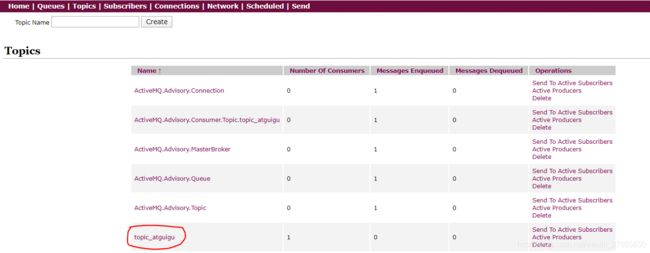
再启动生产者

凡是订阅者,皆可以收到
queue和Topic对比
JMS与JavaEE关系
JMSDestination:
消息发送的目的地,主要指Queue和Topic
JMSDeliveryMode:
持久和非持久模式,一条持久性的消息:应该被传送一次仅仅一次,这意味着如果JMS提供者出现故障,该消息并不会丢失,他会在服务器恢复之后再次传递。
一条非持久消息:最多会传送一次,这意味着这服务器出现故障,该消息将永远丢失。
JMSExpiration:
消息的过期时间,可以设置消息在一定时间后过期,默认是永不过期。消息过期时间等于Destination的send方法中的timeToLive值加上发送时刻的GMT时间值。如果timeToLive值为零,则JMSExpiration被设为零,表示该消息永不过期。如果发送后,在消息过期时间之后消息还没被发送到目的地,则该消息被清除。
JMSPriority:
消息优先级,从0到9十个级别,0到4是普通消息,5到9是加急消息。JMS不严格按照这十个级别发送消息,但必须保证加急消息要优先于普通消息到达,默认级别是4级
JMSMessageID:
唯一识别每个消息的标识由MQ(消息中间件)产生
消息体:用来封装具体的消息数据
5种消息体格式:
消息属性:

消息的可靠性
 持久性:
持久性:


队列 :

Topic:
topic生产者开启持久化,connection.start()需要在设置持久化属性之后进行
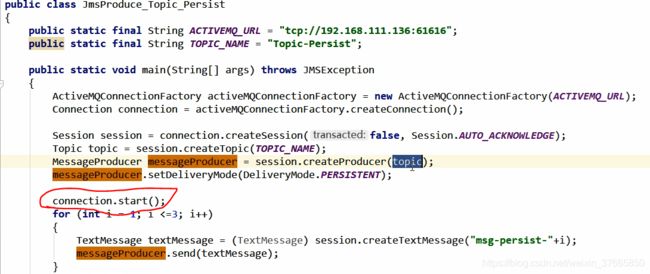
topic消费者开启持久化,需要修改之前消费者接收代码:
 线运行先启动订阅,在启动生产,可见activemq控制台的订阅模块
线运行先启动订阅,在启动生产,可见activemq控制台的订阅模块
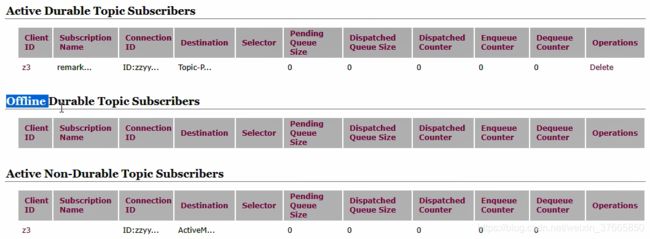
可见活跃的持久化的订阅者信息和离线的订阅者信息

消息生产者和消费者事务介绍

设置事务为true,需在session关闭之前,提交session

生产者不提交事务,消息发送不出去,消费者不提交事务,消息消费不了。
签收
事务偏生产者,签收偏消费者。签收有三种:

手动签收 ,消费者需调用ackonwledeg(),否则消息重复接收
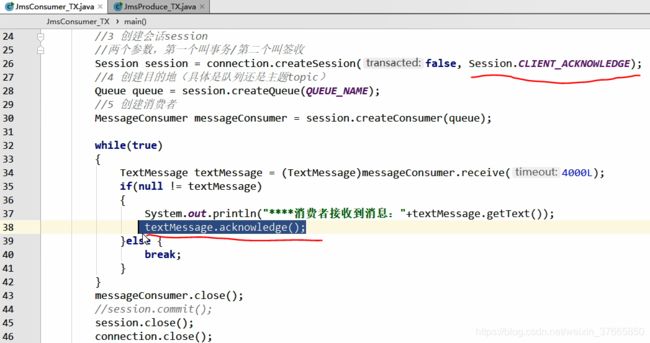
事务和签收的关系:




ActiveMQ Broker:相当于哥ActiveMQ服务器实例,其实就是实现了用代码的形式启动ActiveMQ将MQ嵌入到Java代码中,以便随时用,随时启动,在用的时候再去启动,这样能节省了资源,也保证了可靠性。

启动时通过不同的conf.xml文件模拟不同的实例。
eg:
1:在POM文件 中添加如下依赖:
>
>com.fasterxml.jackson.core >
>jackson-databind >
>2.9.5 >
>import org.apache.activemq.broker.BrokerService;
public class EmbedBroker {
public static void main(String[] args) throws Exception{
//activeMQ也支持在vm中通信基于嵌入式的broker
BrokerService brokerService = new BrokerService();
brokerService.setUseJmx(true);
brokerService.addConnector("tcp://localhost:61616");
brokerService.start();
}
}启动运行,相当于在Windows上启动了一个小型的activeMQ服务,修改之前生产者和消费者的访问服务器地址为本地的localhost,测试可正常发送接收消息。
工作中使用linux的activemq.
![]()
Spring整合ActiveMQ之队列生产者
添加POM依赖
<!--activemq对MS的支持,整合Spring和Activemq-->
<dependency>
<groupId>org.springframework</groupId>
<artifactId>spring-jms</artifactId>
<version>4.3.23.RELEASE</version>
</dependency>
<dependency>
<groupId>org.apache.activemq</groupId>
<artifactId>activemq-pool</artifactId>
<version>5.15.9</version>
</dependency>
<!--Spring-AOP相关jar-->
<dependency>
<groupId>org.springframework</groupId>
<artifactId>spring-core</artifactId>
<version>4.3.23.RELEASE</version>
</dependency>
<dependency>
<groupId>org.springframework</groupId>
<artifactId>spring-context</artifactId>
<version>4.3.23.RELEASE</version>
</dependency>
<dependency>
<groupId>org.springframework</groupId>
<artifactId>spring-aop</artifactId>
<version>4.3.23.RELEASE</version>
</dependency>
<dependency>
<groupId>org.springframework</groupId>
<artifactId>spring-orm</artifactId>
<version>4.3.23.RELEASE</version>
</dependency>
<dependency>
<groupId>org.aspectj</groupId>
<artifactId>aspectjrt</artifactId>
<version>1.6.1</version>
</dependency>
<dependency>
<groupId>aspectj</groupId>
<artifactId>aspectjweaver</artifactId>
<version>1.5.3</version>
</dependency>
<dependency>
<groupId>cglib</groupId>
<artifactId>cglib</artifactId>
<version>2.1_2</version>
</dependency>创建application.xml配置文件
<?xml version="1.0" encoding="UTF-8"?>
<beans xmlns="http://www.springframework.org/schema/beans"
xmlns:xsi="http://www.w3.org/2001/XMLSchema-instance" xmlns:p="http://www.springframework.org/schema/p"
xmlns:context="http://www.springframework.org/schema/context"
xmlns:tx="http://www.springframework.org/schema/tx"
xmlns:aop="http://www.springframework.org/schema/aop"
xsi:schemaLocation="http://www.springframework.org/schema/aop http://www.springframework.org/schema/aop/spring-aop-4.0.xsd
http://www.springframework.org/schema/beans http://www.springframework.org/schema/beans/spring-beans.xsd
http://www.springframework.org/schema/tx http://www.springframework.org/schema/tx/spring-tx-4.0.xsd
http://www.springframework.org/schema/context http://www.springframework.org/schema/context/spring-context-4.0.xsd">
<!-- 配置自动扫描的包 -->
<context:component-scan base-package="com.yx.test.spring"></context:component-scan>
<1--配置生产者-->
<bean id="jmsFactory" class="org.apache.activemq.pool.PooledConnectionFactory" destroy-method="stop">
<property name="connectionFactory">
<bean class="org.apache.activemq.ActiveMQConnectionFactory">
<property name="brokerURL" value="tcp://192.168.215.129:61616"/>
</bean>
</property>
<property name="maxConnections" value="100"></property>
</bean>
<!--这个是队列目的地,点对点的-->
<bean id="destinationQueue" class="org.apache.activemq.command.ActiveMQQueue">
<constructor-arg index="0" value="spring-active-queue"></constructor-arg>
</bean>
<!--Spring提供的JMS工具类,它可以进行消息的发送接收等-->
<bean id="jmsTemplate" class="org.springframework.jms.core.JmsTemplate">
<property name="connectionFactory" ref="jmsFactory"></property>
<property name="defaultDestination" ref="destinationQueue"></property>
<property name="messageConverter">
<bean class="org.springframework.jms.support.converter.SimpleMessageConverter"></bean>
</property>
</bean>
</beans>创建生产者类SpringMQ_Produce
import org.apache.xbean.spring.context.ClassPathXmlApplicationContext;
import org.springframework.beans.factory.annotation.Autowired;
import org.springframework.context.ApplicationContext;
import org.springframework.jms.core.JmsTemplate;
import org.springframework.jms.core.MessageCreator;
import org.springframework.stereotype.Service;
import javax.jms.JMSException;
import javax.jms.Message;
import javax.jms.Session;
import javax.jms.TextMessage;
@Service
public class SpringMQ_Produce {
@Autowired
private JmsTemplate jmsTemplate;
public static void main(String [] args){
ApplicationContext ctx = new ClassPathXmlApplicationContext("application.xml");
System.out.println(ctx.getBeanDefinitionNames()[0]);
SpringMQ_Produce produce = (SpringMQ_Produce)ctx.getBean("springMQ_Produce");
produce.jmsTemplate.send(new MessageCreator() {
@Override
public Message createMessage(Session session) throws JMSException {
TextMessage textMessage = session.createTextMessage("*********Spring和ActiveMQ的整合case********");
return textMessage;
}
});
System.out.println("发送完毕");
}
}import org.apache.xbean.spring.context.ClassPathXmlApplicationContext;
import org.springframework.beans.factory.annotation.Autowired;
import org.springframework.context.ApplicationContext;
import org.springframework.jms.core.JmsTemplate;
import org.springframework.stereotype.Service;
@Service
public class SpringMQ_Consumer {
@Autowired
private JmsTemplate jmsTemplate;
public static void main(String[] args) {
ApplicationContext ctx = new ClassPathXmlApplicationContext("application.xml");
System.out.println(ctx.getBeanDefinitionNames()[0]);
SpringMQ_Consumer consumer = (SpringMQ_Consumer)ctx.getBean("springMQ_Consumer");
String retValue = (String) consumer.jmsTemplate.receiveAndConvert();
System.out.println("*********消费者收到的消息:"+retValue+"***********");
}
}Spring整合activeMQ之Topic
修改application.xml文件,添加topic的bean,并引入到jmstemplate中即可,代码不需修改。
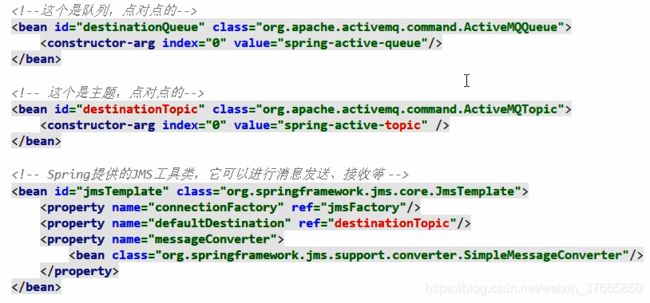
通过spring实现消费者不启动,直接通过配置监听完成,即服务启动就开始监听,生产者一发送消息,就获取到
1)在application.xml中添加监听配置
<?xml version="1.0" encoding="UTF-8"?>
<beans xmlns="http://www.springframework.org/schema/beans"
xmlns:xsi="http://www.w3.org/2001/XMLSchema-instance" xmlns:p="http://www.springframework.org/schema/p"
xmlns:context="http://www.springframework.org/schema/context"
xmlns:tx="http://www.springframework.org/schema/tx"
xmlns:aop="http://www.springframework.org/schema/aop"
xsi:schemaLocation="http://www.springframework.org/schema/aop http://www.springframework.org/schema/aop/spring-aop-4.0.xsd
http://www.springframework.org/schema/beans http://www.springframework.org/schema/beans/spring-beans.xsd
http://www.springframework.org/schema/tx http://www.springframework.org/schema/tx/spring-tx-4.0.xsd
http://www.springframework.org/schema/context http://www.springframework.org/schema/context/spring-context-4.0.xsd">
<!-- 配置自动扫描的包 -->
<context:component-scan base-package="com.yx.test.spring"></context:component-scan>
<!--配置生产者-->
<bean id="jmsFactory" class="org.apache.activemq.pool.PooledConnectionFactory" destroy-method="stop">
<property name="connectionFactory">
<bean class="org.apache.activemq.ActiveMQConnectionFactory">
<property name="brokerURL" value="tcp://192.168.215.129:61616"/>
</bean>
</property>
<property name="maxConnections" value="100"></property>
</bean>
<!--这个是队列目的地,点对点的-->
<bean id="destinationQueue" class="org.apache.activemq.command.ActiveMQQueue">
<constructor-arg index="0" value="spring-active-queue"></constructor-arg>
</bean>
<!--这个是topic目的地-->
<bean id="destinationTopic" class="org.apache.activemq.command.ActiveMQTopic">
<constructor-arg index="0" value="spring-active-topic"></constructor-arg>
</bean>
<!--Spring提供的JMS工具类,它可以进行消息的发送接收等-->
<bean id="jmsTemplate" class="org.springframework.jms.core.JmsTemplate">
<property name="connectionFactory" ref="jmsFactory"></property>
<!-- <property name="defaultDestination" ref="destinationQueue"></property>-->
<property name="defaultDestination" ref="destinationTopic"></property>
<property name="messageConverter">
<bean class="org.springframework.jms.support.converter.SimpleMessageConverter"></bean>
</property>
</bean>
<!--配置监听程序-->
<bean id="jmsContainer" class="org.springframework.jms.listener.DefaultMessageListenerContainer">
<property name="connectionFactory" ref="jmsFactory"></property>
<property name="destination" ref="destinationTopic"></property>
<property name="messageListener" ref="myMessageListener"></property>
</bean>
</beans>创建实现类MyMessageListener
import org.springframework.stereotype.Component;
import javax.jms.JMSException;
import javax.jms.Message;
import javax.jms.MessageListener;
import javax.jms.TextMessage;
@Component
public class MyMessageListener implements MessageListener {
@Override
public void onMessage(Message message) {
if(null !=message && message instanceof TextMessage)
{
TextMessage textMessage = (TextMessage) message;
try {
System.out.println("**************listener"+textMessage.getText());
} catch (JMSException e) {
e.printStackTrace();
}
}
}
}只启动生产者main方法,测试可接受到消息。
springboot整合activeMQ之队列生产者
POM.XML内容如下:
<?xml version="1.0" encoding="UTF-8"?>
<project xmlns="http://maven.apache.org/POM/4.0.0" xmlns:xsi="http://www.w3.org/2001/XMLSchema-instance"
xsi:schemaLocation="http://maven.apache.org/POM/4.0.0 http://maven.apache.org/xsd/maven-4.0.0.xsd">
<modelVersion>4.0.0</modelVersion>
<parent>
<groupId>org.springframework.boot</groupId>
<artifactId>spring-boot-starter-parent</artifactId>
<version>2.1.5.RELEASE</version>
</parent>
<groupId>com.yx.boot</groupId>
<artifactId>boot_mq_produce</artifactId>
<version>1.0-SNAPSHOT</version>
<properties>
<project.build.sourceEncoding>UTF-8</project.build.sourceEncoding>
<maven.compiler.source>1.7</maven.compiler.source>
<maven.compiler.target>1.7</maven.compiler.target>
</properties>
<dependencies>
<dependency>
<groupId>org.springframework.boot</groupId>
<artifactId>spring-boot-starter</artifactId>
</dependency>
<dependency>
<groupId>org.springframework.boot</groupId>
<artifactId>spring-boot-starter-web</artifactId>
</dependency>
<dependency>
<groupId>org.springframework.boot</groupId>
<artifactId>spring-boot-test</artifactId>
<scope>test</scope>
</dependency>
<dependency>
<groupId>org.springframework.boot</groupId>
<artifactId>spring-boot-starter-activemq</artifactId>
<version>2.1.5.RELEASE</version>
</dependency>
<dependency>
<groupId>junit</groupId>
<artifactId>junit</artifactId>
<version>4.12</version>
</dependency>
<dependency>
<groupId>org.springframework</groupId>
<artifactId>spring-test</artifactId>
<version>4.3.23.RELEASE</version>
</dependency>
</dependencies>
<build>
<plugins>
<plugin>
<groupId>org.springframework.boot</groupId>
<artifactId>spring-boot-maven-plugin</artifactId>
</plugin>
</plugins>
</build>
</project>
application.yml内容:
server:
port: 7777
spring:
activemq:
broker-url: tcp://192.168.215.129:61616/
user: admin
password: admin
jms:
pub-sub-domain: false # false表示队列 true表示topic 默认false
#自己定义队列名称
myqueue: boot-activemq-queue配置类ConfigBean内容
import org.apache.activemq.command.ActiveMQQueue;
import org.springframework.beans.factory.annotation.Value;
import org.springframework.context.annotation.Bean;
import org.springframework.jms.annotation.EnableJms;
import org.springframework.stereotype.Component;
import javax.jms.Queue;
@Component
@EnableJms
public class ConfigBean {
@Value("${myqueue}")
private String myQueue;
@Bean
public Queue queue(){
return new ActiveMQQueue(myQueue);
}
}
创建Queue_Produce
import org.springframework.beans.factory.annotation.Autowired;
import org.springframework.jms.core.JmsMessagingTemplate;
import org.springframework.stereotype.Component;
import javax.jms.Queue;
import java.util.UUID;
@Component
public class Queue_Produce {
@Autowired
private JmsMessagingTemplate jmsMessagingTemplate;
@Autowired
private Queue queue;
public void produceMsg(){
jmsMessagingTemplate.convertAndSend(queue,"******:"+ UUID.randomUUID().toString().substring(0,6));
}
}
创建主启动类
import org.springframework.boot.SpringApplication;
import org.springframework.boot.autoconfigure.SpringBootApplication;
/**
* Hello world!
*
*/
@SpringBootApplication
public class MainApp_Produce
{
public static void main( String[] args )
{
SpringApplication.run(MainApp_Produce.class,args);
}
}创建测试类Apptest
@SpringBootTest(classes = com.yx.boot.MainApp_Produce.class)
@RunWith(SpringJUnit4ClassRunner.class)
@WebAppConfiguration
public class AppTest
{
@Resource
private Queue_Produce queue_Produce;
@Test
public void testSend() throws Exception
{
queue_Produce.produceMsg();
}
}运行测试类,可成功发送消息,结果如下:
定时发送消息
eg:每隔3秒钟向MQ推送消息

修改Queue_Produce
@Component
public class Queue_Produce {
@Autowired
private JmsMessagingTemplate jmsMessagingTemplate;
@Autowired
private Queue queue;
public void produceMsg(){
jmsMessagingTemplate.convertAndSend(queue,"******:"+ UUID.randomUUID().toString().substring(0,6));
}
//间隔3秒钟定投
@Scheduled(fixedDelay = 3000)
public void produceMsgScheduled(){
jmsMessagingTemplate.convertAndSend(queue,"**scheduled****:"+ UUID.randomUUID().toString().substring(0,6));
}
}修改主启动类
@SpringBootApplication
@EnableScheduling
public class MainApp_Produce
{
public static void main( String[] args )
{
SpringApplication.run(MainApp_Produce.class,args);
}
}启动主启动类,可见消息按时发送
springboot整合activeMQ之队列消费者

POM文件与生产者POM文件相同
application.yml文件如下:
server:
port: 8888
spring:
activemq:
broker-url: tcp://192.168.215.129:61616/
user: admin
password: admin
jms:
pub-sub-domain: false # false表示队列 true表示topic 默认false
#自己定义队列名称
myqueue: boot-activemq-queue创建消费者类Queue_Consumer
@Component
public class Queue_Consumer {
@JmsListener(destination = "${myqueue}")
public void receive(TextMessage textMessage) throws JMSException {
System.out.println("*********消费者收到的消息"+textMessage.getText());
}
}创建主启动类App
@SpringBootApplication
public class App
{
public static void main( String[] args )
{
SpringApplication.run(App.class,args);
}
}启动主启动类,可见消息接收
springBoot整合ActiveMQ之Topic生产者
server:
port: 6666
spring:
activemq:
broker-url: tcp://192.168.215.129:61616/
user: admin
password: admin
jms:
pub-sub-domain: true # false表示队列 true表示topic 默认false
#自己定义队列名称
mytopic: boot-activemq-topic创建configBean如下:
@Component
public class ConfigBean {
@Value("${mytopic}")
private String topicName;
@Bean
public Topic topic(){
return new ActiveMQTopic(topicName);
}
}创建生产者类Topic_Produce
@Component
public class Topic_Produce {
@Autowired
private JmsMessagingTemplate jmsMessagingTemplate;
@Autowired
private Topic topic;
@Scheduled(fixedDelay = 3000)
public void produceTopic(){
jmsMessagingTemplate.convertAndSend(topic,"Topic生产消息"+ UUID.randomUUID().toString().substring(0,6));
}
}主启动类如下:
@SpringBootApplication
@EnableScheduling
public class App
{
public static void main( String[] args )
{
SpringApplication.run(App.class,args);
}
}Topic消费者
POM文件同上
application.yml文件内容如下:
server:
port: 5566
spring:
activemq:
broker-url: tcp://192.168.215.129:61616/
user: admin
password: admin
jms:
pub-sub-domain: true # false表示队列 true表示topic 默认false
#自己定义队列名称
mytopic: boot-activemq-topic创建Topic_Consumer
@Component
public class Topic_Consumer {
@JmsListener(destination = "${mytopic}")
public void receive(TextMessage text){
try {
System.out.println("消费者收到的Topic消息:"+text.getText());
} catch (JMSException e) {
e.printStackTrace();
}
}
}创建主启动类
@SpringBootApplication
public class App
{
public static void main( String[] args )
{
SpringApplication.run(App.class,args);
}
}先启动消费者,后启动生产者,测试
ActiveMQ的传输协议
ActiveMQ传输协议之NIO

修改activemq.xml,注意端口号61618,注释tcp的(也可不注释),添加nio的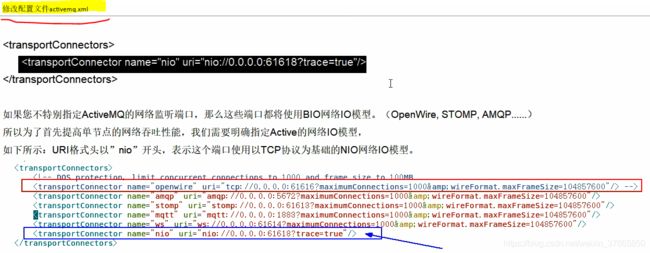
修改生产者消费者连接如下:![]()
完成!

修改activemq.xml注释掉nio,添加如下配置:

修改生产者和消费者的协议端口为61608,即可既支持NIO,又支持多个协议





